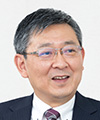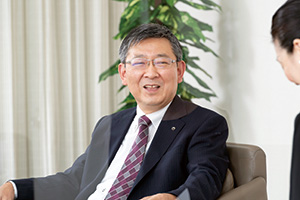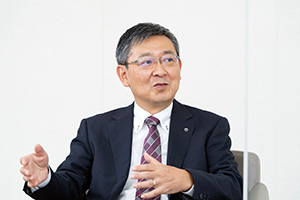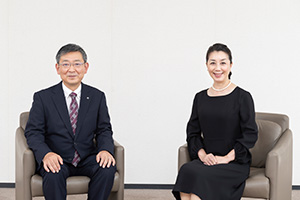 |
|
|
|
|
|
View from the Top Vol. 19, No. 10, pp. 1–5, Oct. 2021. https://doi.org/10.53829/ntr202110tp1
Be Altruistic! What You Get in Return Will Come from the Results of Your GivingOverviewThe NTT Service Innovation Laboratory Group aims to create a world in which all people are happy and can live their lives safely, securely, and healthy. Its three laboratories (i.e., NTT Human Informatics Laboratories, NTT Social Informatics Laboratories, and NTT Computer and Data Science Laboratories) research and develop technologies for integrating cyber and physical spaces to create a world in which a harmonious relationship between the Earth, society, and individuals is built. We interviewed Tomoyoshi Oono, senior vice president, head of the NTT Service Innovation Laboratory Group, who is orchestrating the laboratory group’s efforts to solve social issues and create new value by thinking outside the box, about his new mission and the qualities required of top management. Keywords: well-being, cyber and physical, service development We want to create a future in which all people can be happy—You were appointed senior vice president, head of the NTT Service Innovation Laboratory Group in July 2021. First, could you tell us about the laboratory group? In a future society, social problems will be more diversified and the integration of cyber and physical spaces will be increased. The major goal of the NTT Service Innovation Laboratory Group is to help all people live in a state of well-being that satisfies both their wellness and mindfulness in such a society. Specifically, we are researching and developing technology to provide daily food advice and support behavioral changes for long-term management of physical health as well as technology to create “Another Me,” which has the same personality as oneself in cyberspace that can have various experiences, gain knowledge, and feed the results back to oneself in the real space for that person to lead a spiritually fulfilling life. We are also researching next-generation artificial intelligence (AI) that can execute many tasks in a versatile manner with less learning processes, just like the human brain does. We are also researching platform technologies to support a society emphasizing well-being, such as a social system platform to enable the results of the above research and development (R&D) to be widely and ethically accepted in society as well as an AI computing platform to enable AI functions installed in various places in the real space to autonomously interact each other. We are working on these challenging themes by thinking outside the box. The NTT Service Innovation Laboratory Group consists of three laboratories. Taking a human-centric approach, NTT Human Informatics Laboratories conducts innovative R&D to create a new symbiosis between the real and cyberspaces as the development of cyberspace rapidly accelerates. NTT Social Informatics Laboratories carries out wide-ranging research on social values, information utilization, cybersecurity, privacy, ethics, law, regulations, and beyond, to further the transformation and development of social systems and human societies through information and communication technologies. NTT Computer and Data Science Laboratories conducts R&D on innovative computer science and data science that enable the processing of the data that have been difficult to handle due to their scale and complexity and create useful value from those data for people and society. —Could you tell us how you feel about your new position? Prior to assuming my current position, I worked at NTT DOCOMO, where I was mainly involved in the development of the next-personal handy-phone system (PHS) location-information system, promotion of the introduction of the Freedom Of Mobile multimedia Access (FOMA) service, and the development of technologies and services such as the “Otayori Photo Service” for photo/video sharing via mobile phones, “Shabette Concierge” voice-activated user interface, and “Photo Collection” cloud-based photo/video-storage service. When I took my current position in July this year, I was very surprised to find that the world I was aiming for when I was at NTT DOCOMO and the world the NTT Service Innovation Laboratory Group is aiming for is the same. That aim is to create a society in which all people are happy and can live their lives safely, securely, and healthy, which we term a “well-being society.” However, although both NTT DOCOMO and the NTT Service Innovation Laboratory Group share the goal of creating such a society, the former focuses on how to solve the most recent problems, while the latter looks further ahead. This difference lies in their stance: NTT DOCOMO considers what they can do now to develop business, while the NTT Service Innovation Laboratory Group takes on challenges of what they cannot do now to change the world.
In the age of volatility, uncertainty, complexity, and ambiguity, go out into the field and repeat trial and error—Do you feel that your experience at NTT DOCOMO has made a difference in your current work? I try to communicate directly with staff and researchers, and I am sometimes asked, “How can I create a service?” At such times, my long experience in service development at NTT DOCOMO comes in handy. Service development is composed of several phases. The first phase is called “customer-problem fit,” a process in which a customer’s real problem is identified. The second phase is called “problem-solution fit,” a process in which a solution to the identified customer’s problem is found. A minimum number of products are then developed through trial and error, and whether those products are actually useful is verified. Finally, the products and services that solve the customer’s problem are provided. The last phase is called “product-market fit” in which the company’s products and services fitting the market is achieved. However, in this era of volatility, uncertainty, complexity, and ambiguity (VUCA), predicting the future is difficult. Markets, which used to be easy to predict to some extent, have become unpredictable. I therefore believe that we have no choice but to repeat the process of trial and error. I also have always placed importance on going out into the field when creating services. I once visited the city of Unnan in Shimane Prefecture here in Japan to conduct interviews with the elderly. Although it is possible to use online tools or have elderly people come to Tokyo to talk with us, visiting the site ourselves to talk with them allowed us to experience their environment with all five senses, which is something that words and facial expressions alone cannot convey. I was surprised to hear that the elderly people participating in the interviews had no particular problems, despite the fact that Japan is facing the social problems of a very low birthrate and aging population. This experience made me realize that even in a super-aging society, which has been called a social problem, the perspective differs in accordance with the standpoint of ordinary citizens, local government, and the state, and that the things that need to be addressed also varies. It is important to take a close look at the real world in this manner. As I support the activities of researchers, I intend to make them aware of seeing the reaction to their research results in the real world. In fact, some researchers told me of their desire to create a service, release it to the world, and see the reaction. I know this task is difficult during the COVID-19 pandemic, but I want to emphasize the importance of researchers being aware of the real world.
—What is important to you as a field-oriented manager? I often hear people hesitate to try something because they are afraid of failure, but I think we should just try it anyway. As I mentioned earlier, I used to be involved in developing a service called “Otayori Photo Service” for emailing photos via mobile phones. NTT DOCOMO developed the first such service in the world, but while we were making internal procedures to complete the development, another Japanese company announced a similar service to the press. That situation arose because our internal rules required us to finish an internal procedure for completing the development before announcing a new product. We took it as an opportunity to review and change our rules so that we could make press announcements in the pre-launch phase. It was our failure when the other company made a press announcement ahead of us; however, because we tried something new, we were able to uncover issues in the process and improve the situation. In other words, from a different perspective, this failure led to success. I think this example demonstrates the fact that although organizations have rules, researchers should not be too bound by those rules. My former boss used to say, humorously but genuinely, “Rules are there to be broken.” and “You can make your own rules.” Looking back, I welcome that attitude. I also believe that the role of top management is to have their staff feel comfortable in their work. For example, if a rule prevents good work from being done, I, who has the authority to change the rule, should change it. It is my role to make comprehensive judgments, which include risk assessment, and take on the risk if it seems to be a positive move. For the growth of my staff, what I value is to leave the details to the staff. In the past, we used to prepare materials for meetings to put our plans into action by creating a single A3 sheet of paper summarizing the plan from the introduction (background) in the upper left to the conclusion in the lower right. In many cases, the management designated only the introduction and the conclusion and left the creation of materials to their staff. The staff members are free to use their ideas to create a proposal to match the conclusion while taking into account the background, trends followed by other companies, and strengths of their company. I believe that staff members can grow if we give them clear goals and more freedom.
Create the future, rather than predict it—I understand you trust your staff. What qualities and attitudes are required of researchers in the future? In addition to challenging yourself and repeating trial and error as I mentioned, I think it is important to take a backcasting approach; that is, envision the ideal future and then think what should be done now. It is also important to have “intrapersonal diversity,” which is advocated by Professor Akie Iriyama of Waseda University, in other words, a wide range of diversity within one person. The key to innovation is human resources who can build an H-shaped collaboration by connecting their expertise (vertical axis) with other people’s expertise (other vertical axis) using a horizontal axis. I also want researchers to consider NTT’s social mission, which is often referred to as “noblesse oblige” in Europe and the United States. I believe that NTT has the power to change Japan through our Innovative Optical and Wireless Network (IOWN) initiatives, and NTT researchers are in a position to change the world from Japan. I hope that you will fulfill this role. Having passion for goals is what will lead our business to success. Alan Kay said, “The best way to predict the future is to invent it.” In this VUCA era, I want you to approach your research activities with the attitude of creating your ideal future and achieving your goals. Last but not least, the most important thing is to take care of yourself. Professor Satoshi Fukushima of the University of Tokyo, who has vision and hearing impairments says, “No one born in this world is unnecessary.” Life is short, so I hope that you will take good care of yourself and live your life with no regrets. However, remember to be altruistic. Life is about “give and give,” rather than “give and take.” What you get in return will come from the results of your giving. Interviewee profileCareer highlightsTomoyoshi Oono joined Nippon Telegraph and Telephone Corporation (NTT) in 1989. In 1999, he moved to NTT DOCOMO, where he was responsible for the development of NTT DOCOMO’s next-PHS location-information system and promoting the introduction of FOMA. He became a senior vice president and head of the R&D Strategy Department/Innovation Management Department of NTT DOCOMO in 2017. After concurrently serving as a member of the Board of Directors of NTT DOCOMO Ventures, Inc. from 2018 and as president of Mirai Translate, Inc. from 2020, he started his current position in July 2021. |




